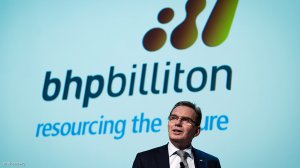PERTH (miningweekly.com) – Diversified major BHP Billiton on Wednesday lowered its metallurgical coal and copper production targets, narrowed its iron-ore guidance and said that it plans to sell some noncore US shale gas acreage.
The mining major reduced its metallurgical coal production guidance for the 2017 financial year, which will end in June, to between 39-million and 41-million tonnes, from a previous guidance of 44-million tonnes. The lower production forecast is the result of third-party rail infrastructure damage caused by Cyclone Debbie.
BHP produced 10.13-million tonnes of metallurgical coal in the March quarter, which is a 2% increase on the March 2016 quarter, but a 5% decrease on the December quarter performance.
Energy coal production was up 9% on the March 2016 quarter, to 7.4-million tonnes. The group expects to produce 30-million tonnes of energy coal in the 2017 financial year.
Following 44 days of industrial action at the Escondida mine, in Chile, BHP has reported a 20% decline in copper production in the nine months ended March, which reached 939 000 t. In the third quarter, the miner reported copper production of 227 000 t, which was down 44% on the previous corresponding period.
As a result of the strike, which ended in March, BHP now only expects to produce between 1.33-million and 1.36-million tonnes of copper, compared with a previous guidance of 1.62-million tonnes.
The iron-ore production guidance has also been narrowed to between 231-million and 234-million tonnes, compared with a previous range of 228-million to 237-million tones.
BHP reported record iron-ore production from its Pilbara operations in the nine months to date, along with record production at five of its Queensland coal mines, producing 171-million tonnes of iron-ore, up 3% on the previous corresponding period. The March quarter’s production increased by 1% year-on-year to 54-million tonnes, but it was an 11% decrease on the December quarter’s production.
Iron-ore production for the nine-month period increased as a result of the successful completion of commissioning of a new primary crusher and additional conveying capacity at the Jimblebar mine, as well as ongoing progress on rail renewal and maintenance programmes and productivity improvements.
Meanwhile, petroleum production for the year-to-date was down 15% to 157-million barrels of oil equivalent, with quarterly production also down 15% on the previous corresponding period to 50.6-million barrels of oil equivalent.
Onshore US liquid volumes decreased by 33% during the nine months under review, as a result of a reduction in activity in the Black Hawk for value, and natural field decline at Hawkville, which more than offset increased liquids production from the Permian.
Conventional liquid volumes also decreased by 8%, as an additional infill well at the Mad Dog operation, and higher production at Algeria and North West Shelf, offshore Australia, was partially offset by planned maintenance at Atlantis and natural field decline across the portfolio.
During the period under review, BHP approved the $2.2-billion Mad Dog Phase 2 project, which is a southern and south-western extension of the existing Mad Dog field, in the Gulf of Mexico. The project includes a new floating production facility with the capacity to produce up to 140 000 bbl/d of crude oil from 14 production wells. Production is expected to start in 2022.
BHP CEO Andrew Mackenzie said that the company continued to add value to its portfolio across each of its six focus areas.
“We continued our targeted high-return investment in shale with the approval of two more rigs in the Haynesville, supported by our hedging strategy.”
Mackenzie also revealed that plans to monetise a portion of its noncore acreage for value, such as parts of the southern Hawkville, were under way.
The group is selling 50 000 acres in the southern Hawkville and has already received bids, which are under evaluation. The Fayetteville acreage is also under review and BHP has indicated that all options, including divestment, are being considered.
The news of a US shale sale comes only weeks after Elliot Advisors urged BHP to split off its US oil and gas division – a move the resources major rejected.
Meanwhile, Mackenzie noted that BHP had significantly reduced the capital intensity of its growth options and changed its approach in shale to improve returns and lower risks on new investments.
“Our more focused approach in exploration is delivering results with three discoveries over the last 12 months, and our new technology function will unlock further value.”
Following the demerger of South32, and some $7-billion worth of divestments, which reduced the company’s portfolio by over a third, the company has been allowed to lower unit costs by over 40%.
Edited by: Mariaan Webb
Creamer Media Senior Deputy Editor Online
EMAIL THIS ARTICLE SAVE THIS ARTICLE
ARTICLE ENQUIRY
To subscribe email subscriptions@creamermedia.co.za or click here
To advertise email advertising@creamermedia.co.za or click here













